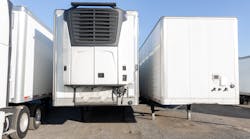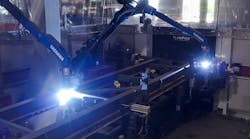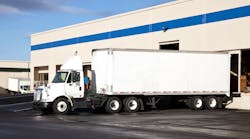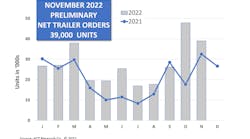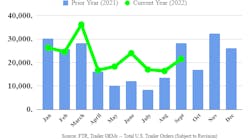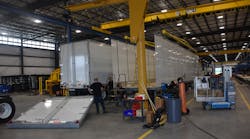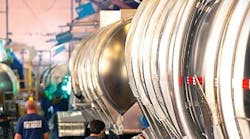The top 25 truck trailer manufacturers (plus four) produced 234,870 trailers in the year 2012. That was a 9.4% increase over 2011, but still far short of the number produced in the boom year of 2006. The Top 25 built 282,750 trailers in that pre-recession peak year, or 47,880 trailers more than in 2012.
The six largest manufacturers built three-fourths of the production by the Top 25. This group of six increased production by 6.7%, compared to the 9.4% increase by the whole group of 25. This would suggest that the medium-size and smaller manufacturers increased their unit volume more than the largest builders.
Van trailers remained strong in 2012, but platform trailers were even stronger. Manufacturers reported big increases in platform trailer production, and yet housing construction has not rebounded in strength. Builders report fleets are buying mainly for replacement of aging flatbeds, not expanding their fleet. Expansion of fleet numbers may come in the big year of the future, 2014.
This is the 20th year that Trailer/Body Builders has conducted this annual survey of trailer output by individual companies. The list of companies that participated in that first survey has changed significantly. Our first survey showed Great Dane Trailers in the top spot with 24,700 trailers built in 1993. Wabash National was in second place with 22,600 trailers. Next was Trailmobile, followed by Utility Trailer, Stoughton, Strick, Pines, Dorsey, Monon, and finally Fruehauf in tenth place.
Containers were big that year. Six of the top ten also built containers or chassis. Great Dane produced more than 7,000 containers and 7,000 chassis in 1993.
The following year the list was expanded to 17 trailer manufacturers, then 21 builders in 1995. Since then, the focus has been on the Top 25 or more.
This Trailer/Body Builders survey is made by personally telephoning a member of the management team at each manufacturing company. The ranking of the companies does not necessarily reflect their relative success in terms of profitability or revenue received. The dollar value of a trailer can vary greatly depending on design, type of construction, materials used and quality level.
The trailer totals reported here cannot be compared directly with other domestic surveys that do not also include some Canadian and Mexican trailer assembly plants, nor does this survey attempt to cover the many small trailer manufacturing companies located throughout North America.
Wabash National Corporation shipped 45,600 new truck trailers in 2012, down by 2,000 units or 4% from the previous year. (The 2011 trailer shipments figure was restated upward this year by the company from the former 46,526 units to 47,600 units). The Wabash total trailer shipments figure for 2012 also includes the tank trailers produced by the Walker Group Holdings, which Wabash acquired May 8, 2012.
Dry freight van shipments declined 13% at Wabash to 35,100 vans in 2012, while refrigerated vans held steady at 4,200 reefers. Transcraft platform shipments increased 52% to the 3,000 level. Walker liquid tank trailers and WNC vacuum transports numbered 3,000 for the full year. Wabash also built 1,400 converter dollies, which are not counted in the truck trailer total, nor are the 500 non-trailer tank trucks built by the Walker Group
“It was a tremendous year of transformation for Wabash National which is highlighted in the year-over-year improvement in our financial results,” stated Dick Giromini, president and chief executive officer. “Specifically, 2012 net sales of $1.5 billion set a company record, while gross margin of 11.2% represents the highest level since 2004 and a year-over-year improvement of 560 basis points or double last year's performance.”
“New trailer shipments of 45,600 for the year were slightly below our prior guidance of 46,000 to 48,000 units,” Giromini continued. “As we look forward to 2013 with a healthy backlog of orders totaling $666 million…..we believe 2013 has the potential to be another record year for Wabash National.”
Great Dane Limited Partnership shipped 44,000 truck trailers in 2012, a 13 percent increase over 2011 shipments. The biggest share of these are dry van trailers, followed by refrigerated trailers and platforms.
In April 2012, Great Dane opened its new, automated refrigerated manufacturing plant in Statesboro, Georgia, 50 miles from the company's roots in Savannah. When fully operational and staffed, it will have a capacity of over 5,000 reefer trailers per year. The 450,000-sq-ft plant joins seven other Great Dane manufacturing facilities strategically located throughout the country.
While the opening of the Statesboro plant was Great Dane's major move in 2012, the company also made some improvements to its platform manufacturing facility in Huntsville, Tennessee. Platforms are a market that should be strengthening in 2013.
“We are happy about the overall year we had last year and what we see for 2013,” says Jon Jeffries, vice president and general sales manager. “We brought the new reefer plant online in April and were able to increase production gradually without overloading it. Plus, the changes we made in Huntsville enabled us to address customer needs and improve production flow.
Looking to 2013, Jeffries believes overall production will be much like last year.
“Housing appears to be picking up, which should drive some flatbed sales,” he says. “Our activity level for quotes is very good right now.”
Utility Trailer Manufacturing in City of Industry, California, produced more truck trailers than ever before, topping the previous high mark set in 2006 by over a thousand trailers. Utility built 37,719 trailers in 2012, a 13% increase over the previous year.
The biggest gain was in dry freight vans, a total of 16,253 vans, up 27% over 2011. Refrigerated vans held steady at 18,366 (up 122 units), but Utility was already the largest refrigerated trailer manufacturer in the world, building more than half of the U. S. industry total of reefer trailers. Platforms and curtainsiders also had a substantial gain of 36% to 3,075 trailers.
This increase in total trailer shipments was made easier by a $13-million capital expenditure expanding facilities. A second assembly line was added at the Virginia dry freight plant. A modification center was added to the Virginia refrigerated plant and to the Paragould, Arkansas, dry freight plant. These “mod centers” help speed the main assembly lines by adding the specialty stuff off-line, such as tailgate lifts, compartment dividers, in-floor power lines, and decals.
The outlook for 2013 is very positive, says Craig Bennett, senior vice-president, sales and marketing. “Dry freight vans are strong. Refrigerated trailers remain steady at a high level. Platforms will remain weak until housing construction gets going again.”
Hyundai Translead held steady on the total number of truck trailers shipped, but expanded greatly its dry van trailer production. Hyundai produced 21,500 dry vans in 2012, an increase of 31% over the previous year. Refrigerated trailer production remained steady at 1,100 units. The company also produced 100 platforms, a new design in which all steel parts and frames are galvanized.
Hyundai took a big hit on container chassis. Production dropped 5,000 units from a year ago, falling in 2012 to 2,800 chassis. Domestic container output numbered 750 of the big boxes, and converter dollies were also 750. The containers and dollies are not counted in the total of 25,500 complete truck trailers at Hyundai, which is only slightly higher than the 2011 figure.
“We are looking for a continuation of the same kind of market,” says Brett Bartels, deputy general manager, sales and marketing strategy. “Fleets tell us that about 60% of their dry van purchases are for replacement, and 40% are for fleet expansion.”
Stoughton Trailers LLC increased its production of van trailers and grain trailers by 20%, shipping 11,000 vans. It also produced 2,300 container chassis, which is 500 fewer chassis than in 2011. Adding the van trailers and container chassis totals 13,300 truck trailers, an 11% increase over 2011. Stoughton also built 450 domestic containers, but these big boxes are not counted in the truck trailer total. (Total unit count of van trailers, container chassis and domestic containers is 13,750 units, a 13% increase).
Bob Wahlin, president of Stoughton Trailers, predicts the company will have similar growth in 2013. “With a strong backlog and more hiring to fill our growing second shift, we think we will have an even better year in 2013.” Stoughton's two van plants are in Stoughton and Brodhead, Wisconsin, while containers and chassis are built in Evansville, Wisconsin.
Vanguard National Trailer Corp of Monon, Indiana, increased its trailer output 26% by assembling 10,326 trailers in 2012. Of these, 8,814 were dry vans, an increase of 25%, and 1,512 were refrigerated trailers, up 35%.
“We will grow both of these segments in 2013,” says Charlie Mudd, president of Vanguard National. “We are continuing to make small improvements in our assembly plant to expand our production capability”.
MANAC built 7,000 truck trailers in 2012, an 8% increase over 2011, “We had a good year,” says Charles Dutil, president. “It was good even though we ended 2012 with a slightly lower backlog than we started. We expect 2013 will be similar. We have a good mix of vans, flats and vocational trailers in our three plants.”
MANAC has its headquarters plant in Quebec, Canada, plus two plants in the United States, building bottom dump trailers in Kennett, Missouri, and platform trailers in Oran, Missouri.
Fontaine Trailer Company increased its output by 75% in 2012, turning out 6,082 platform and lowbed trailers. (About 10% of this number were remanufactured platforms from the Fontaine Renew plant in Jasper, Alabama.) Fontaine had more than doubled its production the previous year.
“Buyers are replacing worn-out equipment,” says Hank Prochazka, president of Fontaine Commercial Trailer. “They haven't bought many trailers for five or six years, so these are replacements”. He says that ordering started out slow at the beginning of 2012, but picked up in the spring. Then in the fall it dropped back again waiting for the elections. The company ended the year with a lower backlog than the previous year-end.
Prochazka thinks that 2013 will be another “average year” like 2012 was. Trailers, and especially platforms, won't return to really volume production until the housing market gets out of the recession.
Strick Corporation built 4,400 total trailers in 2012 which represents a strong showing in its specialized van and platform market, but a changing market in the specialized container chassis field.
Strick built 1,600 custom dry freight vans at its Monroe, Indiana, plant, an increase of 100 vans or 7%, and 300 platforms and logging trailers at its Sumter, South, Carolina plant, also an increase of 100 trailers (50%) over 2011. However, specialized container chassis produced at its Berwick, Pennsylvania, plant were down 29% to 2,500 chassis. Compared to the 5,200 trailers and chassis produced in 2011, Strick's unit count was down by 800 units or 15%.
Ben Katz, marketing manager, says their 2011 production of 3,500 specialized chassis for heavy or mixed sizes of containers was unusually high because buyers were playing catch-up, The 2012 chassis production number of 2,500 is more sustainable in the future.
Katz says the outlook for custom vans for heavy loads such as paper rolls or light loads such as beverages is continuing strong. The company is considering adding a second assembly line to the Monroe plant to build a new exterior post van that is more aerodynamic and an open top van for top-loaded heavy cargo. If realized in 2013, this second line could add 25% to their van total.
Heil Trailer International, Co. of Athens, Tennessee, produced 3,800 truck trailers in the United States in 2012, a 22% increase over the previous year's domestic production. Of these, 3,400 were tank trailers produced in the Athens headquarters plant and in Rhome, Texas. The other 400 were lowbed and heavy hauler trailers built in the Kalyn Siebert facility in Gatesville, Texas.
In the international market, Heil also produced trailers at its plants in Canuelas, Argentina and Bangkok, Thailand, but these are not counted in the North American totals reported here.
Heil Trailer is planning for another good year in 2013, especially in petroleum tanks and the heavier pneumatics and crude oil tankers, says Jay Morfitt, director of sales and marketing. He thinks industry sales of petroleum tanks will be up about 25% this year. The higher capacity dry bulk pneumatics are still strong, but dry bulk tanks of less than 1600 cubic feet capacity are softening. Likewise, the market for crude oil tanks of 9,000 gallons or less is soft, while those of 10,000 gallons and more is increasing.
MAC Trailer Manufacturing of Alliance, Ohio, had another record year — up 37% over 2011. The company built 3,891 all-aluminum truck trailers in 2012, and has a six month backlog in the new year.
Platform trailers led the increases, up 64% to 1,444 all-aluminum flatbeds and drop-decks. Dump trailers at 1,090 (including 250 steel dumps) and refuse transfer trailers at 361 combined to 1,451 units, up slightly over the previous year. Pneumatic dry bulk tanks jumped 36% to 700 units. And the new line of aluminum liquid tanks in 2012 went from zero to 296 units produced. Not counted in the trailer total are 106 straight truck bodies.
“We are expanding our new product line of aluminum liquid tanks,” says Mike Conny, president. “Instead of just water tanks, we are adding Type 406 and 407 petroleum tanks, and also stainless steel tanks for chemicals. We expect to more than double our shipments of liquid tanks in 2013.”
Timpte Inc in David City, Nebraska, built 3,100 grain trailers in 2012, down 13%. “We started the year strong and were on schedule for the first six months,” says Dale Jones, president. “Then when it didn't rain all summer, sales dried up as the corn withered in the fields. It was the worst drought in 60 years, and it was all across the Midwest, our principal market area. But we kept producing. We didn't lay anyone off.”
When the rains did come in the fall, some of the crop survived. Sky-high grain prices helped revive customer buying toward the end of the year. With corn topping out at $8.55 a bushel and soybeans at $18, buyers were ready to invest in new equipment.
“We think 2013 will be a good year — if we get the moisture,” says Jones. Timpte also expanded its product line with its new Thunder powered tarp. It seals tightly enough to haul sensitive loads such as cement or plastic beads. It is an all-welded tarp with no stitching that makes holes in the vinyl material.
Reitnouer Inc in Reading, Pennsylvania, outdid last year's prediction by ten percent. They built 2,750 all-aluminum, bolted design platform trailers, a 79% increase over 2011 production.
“We ramped up quickly from our 50 a week at the start of the year and reached a high point of 319 for the month of November,” says Bud Reitnouer, president. “We could have sold more if we could have made more. Now we are building at the rate of 70 a week and are booked for four months. We hope to build 3,500 all-aluminum platforms in 2013”.
He thinks fleets are looking for lighter weight trailers to offset the heavier truck tractors needed now. Road de-icing chemicals also play a role in the increasing market share for all-aluminum designs.
Bud Reitnouer started his company 30 years ago with the same concept he is using today — an all-aluminum, bolted design. He believes his company may reach its all-time highest volume level in 2013.
Road Systems Inc in Searcy, Arkansas, turned out 2,548 new-built, remanufactured and refurbished van trailers, a modest 2% increase over 2011. New-built vans were 139, while 2,053 were remacs and 356 were refurbished. Both remacs and refurbished vans get a new-built van body on a completely remanufactured running gear, but are taxed differently.
Road Systems is a wholly owned subsidiary of Con-way Inc, and 80% of these trailers are for the parent company and 20% are for outside companies. Some 1,500 of the total units were 28-ft doubles trailers and 1,048 were 45, 48, and 53-ft long trailers.
Lynn Reinbolt, president of Road Systems, says he is expecting a 25% increase in output in 2013.
Trail King Industries of Mitchell, South Dakota, built 2,519 truck trailers, a 33% increase over 2011. The biggest part of this increase came in the lowbed and heavy haul segment, which was up 31% to 1,479 units. Other segments were 398 pneumatic dry bulk trailers, 325 bottom dump and side dump trailers, and 317 live floor trailers. The company also built 213 light-duty tag trailers with axle capacity under 10,000 lb, which are not counted in the truck trailer total. If they were, the total unit count would be 2,732.
“It was a good year, but it slowed in the fourth quarter,” says Chuck Noel, vice-president, administration. “Now ordering is picking up again in 2013. We finished with a good backlog, but we are looking forward to a flat year or only a small increase in 2013. Dry bulk pneumatic trailers in particular will be down because of the threat of more EPA regulations affecting fracking in oil drilling operations.”
Trail King operates two trailer manufacturing plants — a new plant in West Fargo, North Dakota, and the headquarters plant in Mitchell. Since October 2010, Trail King has been a part of CC Industries Inc of Chicago.
Polar Tank Trailer of Holdingford, Minnesota, built 2,500 tank trailers in 2012, a six percent increase. “We sold more trailers than we could produce,” says Ted Fick, president and CEO of Polar Corp. “We under-estimated the downtime we would have during our $10-million expansion and retooling program at all three plants.” (See Dec. 2012 TBB pages 18-21).
Polar also added 800 more employees during the 18-month long retooling program to keep up with demand, and its backlog stretched out to 10 and 12 months. “Now with our increased efficiency and technology improvements, that backlog has shrunk to 6 to 7 months,” says Fick. “Now we are ready for the next tank trailer demand cycle.”
He thinks 2012 was the peak of the current cycle, when the tank trailer industry built 10,700 tanks. Now production will “glide slowly down” to 10,200 tank trailers in 2013, and then to a low demand year of 8,000 trailers in 2016, which will be the bottom of the economic cycle before starting a new upward market cycle.
Over the past few years, Polar has grown to a 30 to 32% market share of the U. S. tank trailer industry total. However, because of plant rearrangements during the 2012 retooling program, that share slipped to less than 25% of the 2012 tank industry total. “For 2013, Polar will restore its traditional market share position,” says Fick. “We will build more than 3,000 tank trailers in 2013,”
“The energy sector has added approximately 30% to the demand for tank trailers,” says Fick. “Chemical trailers are the hottest type right now, followed by petroleum tankers. This will keep on growing. Pneumatics for frac sand will level off, though, because of the limitations on sand production”.
East Manufacturing Company in Randolph, Ohio, built 2,319 all-aluminum dump and platform trailers in 2012, a 45% increase over 2011. Most of that increase came in the all-aluminum platform market. More than half of East's sales were in platforms, which usually constitute 10% to 25% of their sales. In 2012, the platform share jumped to 52%.
“Buyers tell us that these are replacements, not new additions to the fleet,” says David de Poincy, president of East Mfg. “Many are replacements for combination steel-aluminum platforms. The sodium chloride and magnesium chloride road deicers are eating up the steel frames of the combos.”
Trailer ordering is brisk now for the spring construction season, but De Poincy is looking forward to a 2013 build of only a little better than 2012. “We think 2014 and 2015 will be banner years, when housing construction finally gets going again”.
Pitts Enterprises of Pittsview, Alabama, turned out 2,126 truck trailers in 2012, a 41% increase over the previous year. This includes logging trailers, forestry equipment, and lowbeds built at the headquarters plant in Pittsview, and dry vans, refrigerated trailers, chip vans, and platform trailers built at the Dorsey Trailer plant in Elba, Alabama. A third division, Dynaweld in Columbus, Georgia, distributes platform trailers and lowbeds.
Looking ahead to 2013, Jeff Pitts, president and CEO, says they are expecting the strong market will continue, and they are looking for an increase from their expanded product line.
Dorsey will roll out in the second quarter a redesigned combination steel and aluminum platform trailer in both flatbed and drop-frame models. Dorsey has not built a combo platform in the past seven years, so this will be a reintroduction of a proven but updated model.
Tremcar Inc, manufacturer of liquid and dry bulk tank trailers in the U. S. and Canada, built 1,570 trailers in 2012, a 61% increase over 2011, which had been a 67% increase over the previous year. The strongest showing was in crude oil tankers, keeping up with the boom in the oilpatch.
“It was a crazy year,” says Daniel Tremblay, president. “We don't expect to see a repeat in 2013. In fact, we are looking for a 10% to 15% downturn because of the slowing in the oilfield.”
Tremcar builds a full line of liquid tank trailers including stainless steel models for chemicals, and for food and dairy products, as well as dry bulk pneumatic trailers. Their three manufacturing plants are located in Montreal and Toronto, Canada, and Strasburg, Ohio.
Kentucky Trailer in Louisville, Kentucky, built 1,435 trailers, off slightly in unit numbers from 2011 but still a very good year. “We had a better mix of custom-built drop-frame vans for the moving and storage industry and higher revenue,” says Larry Roy, executive vice-president and CFO.
A subsidiary company, Kentucky High Performance Trailers, was moved out of the main manufacturing plant to its own building in Louisville in November 2012. “We are hoping to see an improving market in replacements of the trailers built in the early days of the motor sports boom,” says Roy.
Doepker Industries in Anaheim, Saskatchewan, Canada, had a very good year building 1,400 truck trailers, a 27% increase. Revenue was even better, up 60% because of the mix of models and the expansion of the oilfield market. Forestry equipment was also strong. Doepker's diverse line also includes ag trailers, gravel haulers, detachable gooseneck lowbeds, commercial flatbeds, and curtainsiders.
Bill Shuler, VP-sales and marketing, says Doepker will do even better in 2013, predicting 35% growth to the 1,900-trailer level.
Kidron of Kidron, Ohio, built 20 refrigerated trailers more than in 2011, shipping 1,114 truck trailers. “Many of our customers bought power units in 2012,” says John Sommer, executive vice-president at Kidron. “Perhaps next year they will buy more trailers.”
All of Kidron's foam-insulated refrigerated trailers are built in Montgomery, Pennsylvania, in a plant capable of handling trailers up to 53 feet long. Kidron also has three refrigerated truck body plants in Kansas, Ohio, and Pennsylvania, and that business grew over 20% in 2012, says Sommer.
Western Trailer in Boise, Idaho, built 958 truck trailers, a 20% increase over 2011. Flatbeds were up sharply, and bulk commodity trailers for agriculture and forestry products were also good. Tod Swanstrom, engineering manager, says the company is expecting another year at the same level, or perhaps a 10% increase.
Felling Trailers of Saux Centre, Minnesota, built 840 truck trailers in 2012, a 48% increase over 2011. The company also produced 2,085 light-duty trailers with axle capacities under 10,000 lb, a 30 % increase over the previous year.
Felling produces heavy-duty trailers from bumper-pull tag trailers up to 120-ton lowbeds. In fact, its hydraulic detachable trailer line is sold out for the year, and there is a six-month backlog for hydraulic tail trailers. Its 48-ft steel drop-deck trailer is popular for hauling equipment, and also for hay hauling.
In view of the rapidly filling order book, Felling Trailers is expecting a 25% to 30% increase in volume during 2013, says Pat Jennissen, sales and marketing manager.
Doonan Specialized Trailer in Great Bend, Kansas, built 811 truck trailers in 2012, a 49% increase, after doubling output the previous year. The increase was spread equally over all three product lines: Chaparral all-aluminum platforms, Doonan steel and combo flatbeds, and Doonan oilfield and removable gooseneck lowbeds.
Doonan is going into 2013 with a six-month backlog, but expects the total number of units produced to increase only modestly. “We ramped up production during the first half of 2012, and are not anticipating another big expansion,” says Mike Gordy, president.
Talbert Manufacturing in Rensselaer, Indiana, built 731 lowbed and heavy hauler trailers in 2012, a 27% increase over the previous year. Heavy trailers for hauling combines and similar ag equipment were especially hot at the beginning of the year, but ordering tapered off when the rains didn't come. The oil patch was also strong.
“Our estimate for 2013 is about the same, subject to the political uncertainty,” says Greg Smith, VP sales and marketing. “All market conditions are positive outside Washington DC.”
Travis Trailers of Houston increased production 19% to turn out 630 aluminum dump trailers, bottom dumps, and refuse transfer trailers in 2012. A good part of this increase came from their acquisition of the assets of Everlite Inc and its Alumatech brand in 2011. Over 100 Alumatech dump trailers were built in 2012, and the other Travis production remained strong.
Bud Hughes, president of Travis Trailers, says sales were good for the first half of 2012, but started slowing in August. Then orders picked up again in November and December, and now the company has a three-month backlog. It is hiring more people and increasing production, he adds.
Towmaster Trailers in Litchfield, Minnesota is a new member of the Top 25 Club, in a runner-up position. Towmaster has been building trailers for almost 40 years, starting out with lightweight tag trailers and moving up to the heavier truck trailer category (at least one axle over 10,000-lb capacity) about 1980. The company came out with a detachable gooseneck lowbed in 2002.
In 2012, Towmaster built 601 of these heavier trailers with capacities of 20,000-lb or greater. That is a 20% increase over the previous year. Not counted in that truck trailer total are the approximately 2,500 lightweight tag trailers under 20,000-lb capacity that were built each year.
“Our 2013 production is starting very strong,” says Chris Pokornowski, national sales manager. “We are planning on a 17% increase this year.
